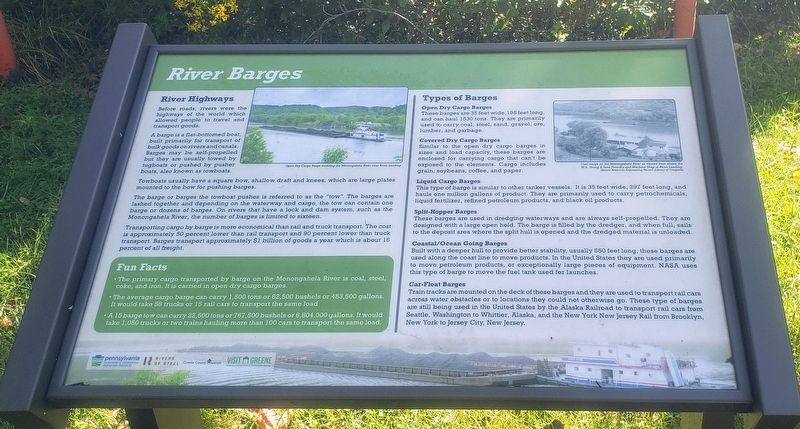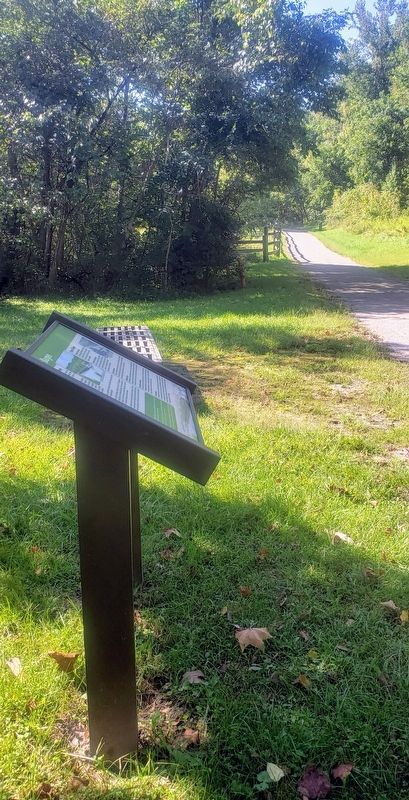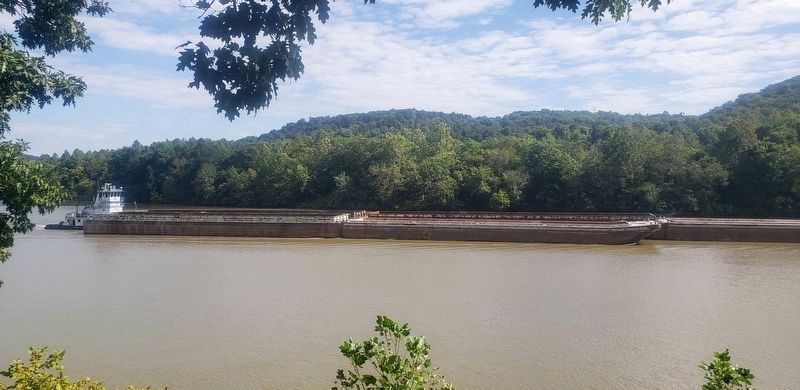Jefferson Township near East Millsboro in Greene County, Pennsylvania — The American Northeast (Mid-Atlantic)
River Barges
River Highways
Before roads, rivers were the highways of the world which allowed people to travel and transport goods.
A barge is a flat-bottomed boat, built primarily for transport of bulk goods on rivers and canals. Barges may be self-propelled but they are usually towed by tugboats or pushed by pusher boats, also known as towboats.
Towboats usually have a square bow, shallow draft and knees, which are large plates mounted to the bow for pushing barges.
The barge or barges the towboat pushes is referred to as the "tow". The barges are lashed together and depending on the waterway and cargo, the tow can contain one barge or dozens of barges. On rivers that have a lock and dam system, such as the Monongahela River, the number of barges is limited to sixteen.
Transporting cargo by barge is more economical than rail and truck transport. The cost is approximately 50 percent lower than rail transport and 90 percent lower than truck transport. Barges transport approximately $1 billion of goods a year which is about 15 percent of all freight.
Fun Facts
• The primary cargo transported by barge on the Monongahela River is coal, steel, coke, and iron. It is carried in open dry cargo barges.
• The average cargo barge can carry 1,500 tons or 62,500 bushels or 453,500 gallons. It would take 58 trucks or 15 rail cars to transport the same load
• A 15 barge tow can carry 22,500 tons or 767,500 bushels or 6,804,000 gallons. It would take 1,050 trucks or two trains hauling more than 100 cars to transport the same load.
Types of Barges
Open Dry Cargo Barges
These barges are 35 feet wide, 195 feet long, and can haul 1530 tons. They are primarily used to carry coal, steel, sand, gravel, ore, lumber, and garbage.
Covered Dry Cargo Barges
Similar to the open dry cargo barges in sizes and load capacity, these barges are enclosed for carrying cargo that can't be exposed to the elements. Cargo includes grain, soybeans, coffee, and paper.
Liquid Cargo Barges
This type of barge is similar to other tanker vessels. It is 35 feet wide, 297 feet long, and hauls one million gallons of product. They are primarily used to carry petrochemicals, liquid fertilizer, refined petroleum products, and black oil products.
Split-Hopper Barges
These barges are used in dredging waterways and are always self-propelled. They are designed with a large open hold. The barge is filled by the dredger, and when full, sails to the deposit area where the split hull is opened and the dredged material is unloaded.
Coastal/Ocean Going Barges
Built with a deeper hull to provide better stability, usually 550 feet long, these barges are used along the coast line to move products. In the United States they are used primarily to move petroleum products, or exceptionally large pieces of equipment. NASA uses this type of barge to move the fuel tank used for launches.
Car-Float Barges
Train tracks are mounted on the deck of these barges and they are used to transport rail cars across water obstacles or to locations they could not otherwise go. These type of barges are still being used in the United States by the Alaska Railroad to transport rail cars from Seattle, Washington to Whittier, Alaska, and the New York New Jersey Rail from Brooklyn, New York to Jersey City, New Jersey.
Captions:
Open Dry Cargo Berge traveling the Monongahela River near Rices Landing.
Coal barge on the Monongahela River as viewed from above the W. A. Young & Sons Foundry and Machine Shop in Rices Landing.
Historic American Engineering Record (Library of Congress)
Erected 2020 by Pennsylvania Department of Conservation and Natural Resources, Rivers of Steel, Greene County Museum, Greene County Tourist Promotion Agency.
Topics. This historical marker is listed in these topic lists: Industry & Commerce • Waterways & Vessels. A significant historical year for this entry is 1530.
Location. 39° 58.198′ N, 80° 0.733′ W. Marker is near East Millsboro, Pennsylvania, in Greene County. It is in Jefferson Township. Marker can be reached from Main Street north of Rices Landing Road (County Route 1010), on the left when traveling north. Marker is located on the Greene River Trail north of the Rices Landing Trailhead parking lot. The parking lot is located on Main Street across from Rices Landing United Methodist Church. Touch for map. Marker is at or near this postal address: 125 Main Street, Rices Landing PA 15357, United States of America. Touch for directions.
Other nearby markers. At least 8 other markers are within 2 miles of this marker, measured as the crow flies. The Abraham Tegarden Family (approx. 0.8 miles away); Watershed (approx. one mile away); Coke & Coke Ovens (approx. one mile away); Dilworth Mine (approx. 1.1 miles away); Gateway Mine (approx. 1.1 miles away); Railroad (approx. 1.3 miles away); Rices Landing (approx. 1.4 miles away); Monongahela River (approx. 1.4 miles away).
Credits. This page was last revised on February 7, 2023. It was originally submitted on September 12, 2021, by Bradley Owen of Morgantown, West Virginia. This page has been viewed 227 times since then and 27 times this year. Last updated on September 15, 2021, by Bradley Owen of Morgantown, West Virginia. Photos: 1, 2, 3. submitted on September 12, 2021, by Bradley Owen of Morgantown, West Virginia. • Bill Pfingsten was the editor who published this page.


